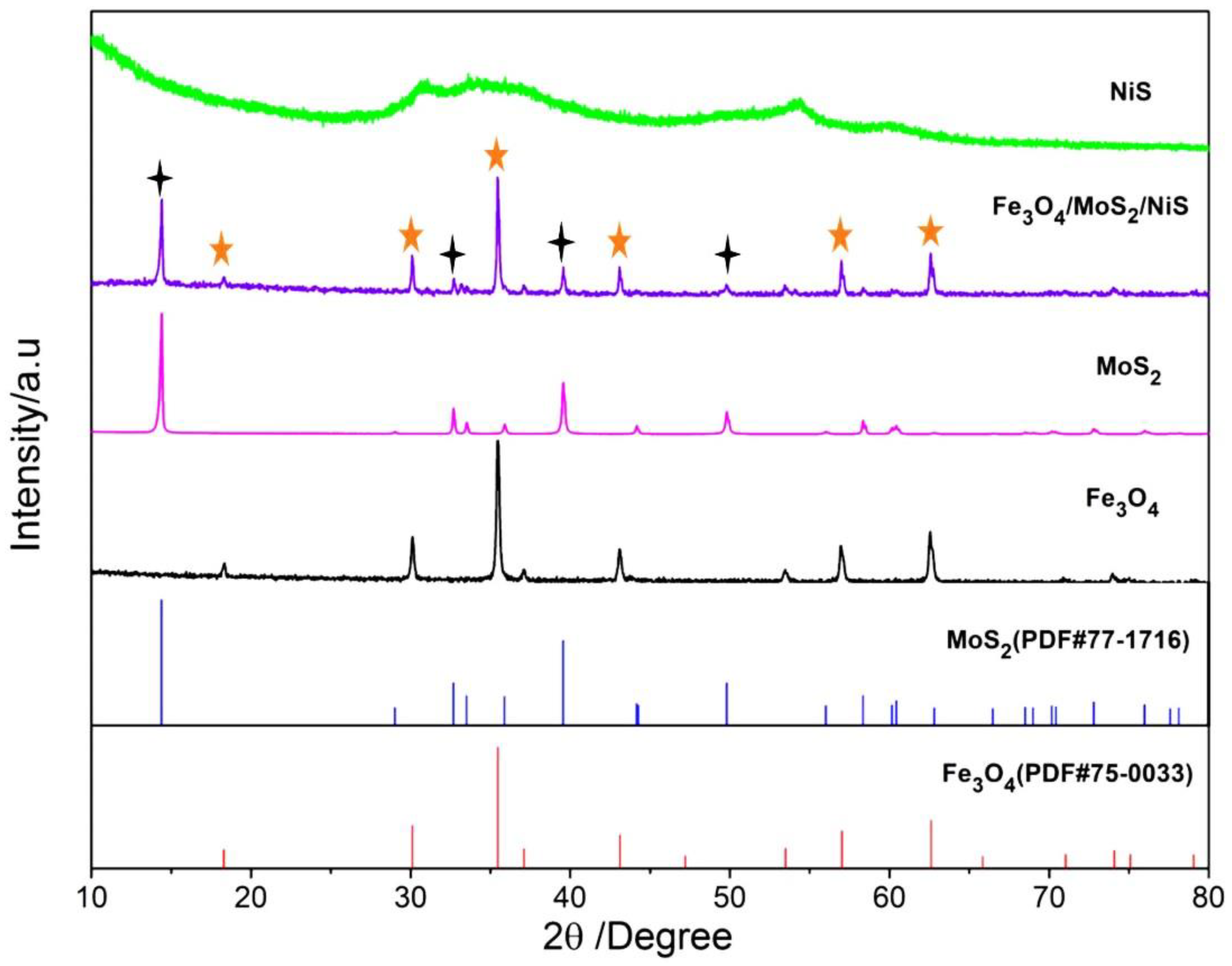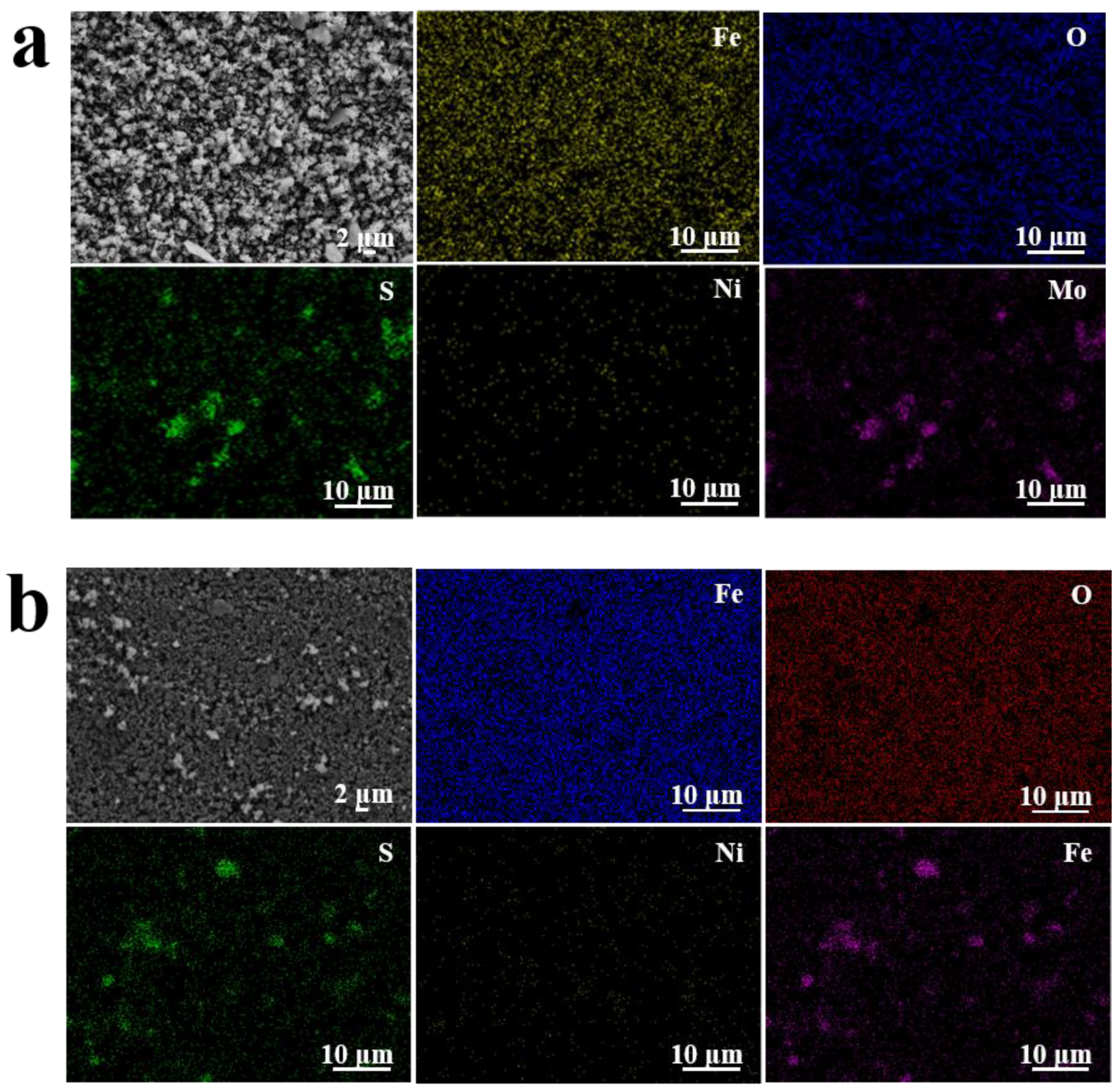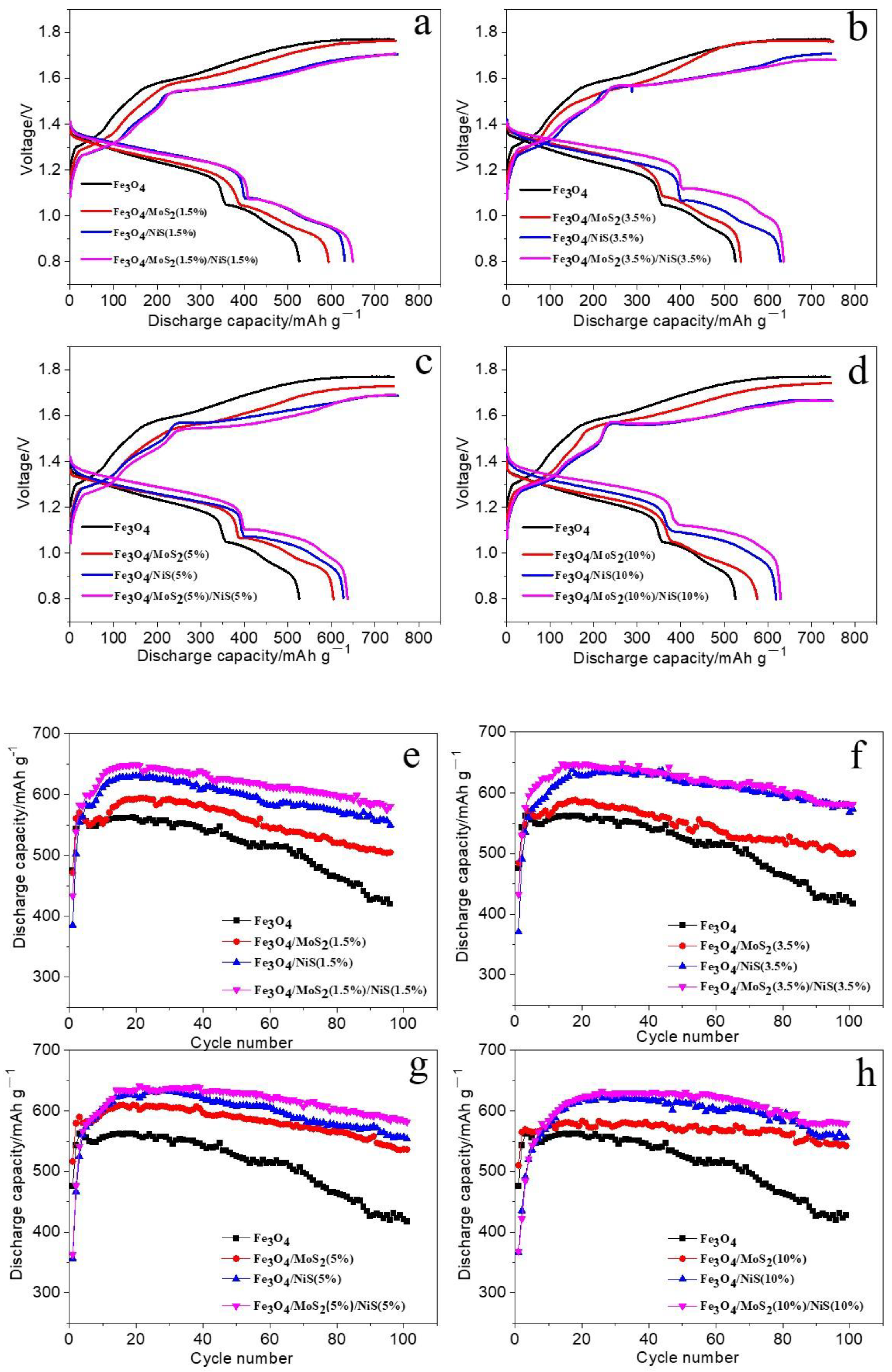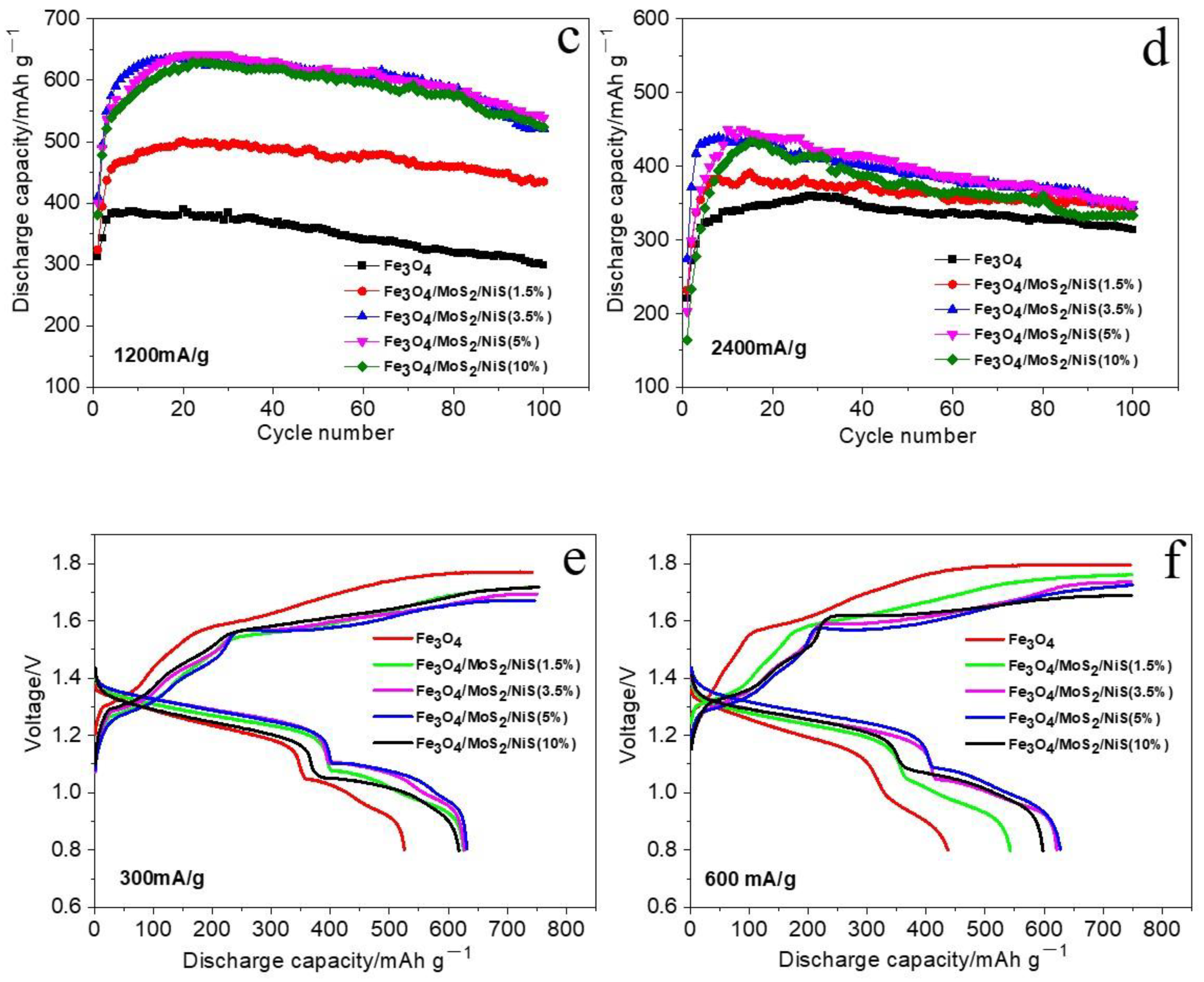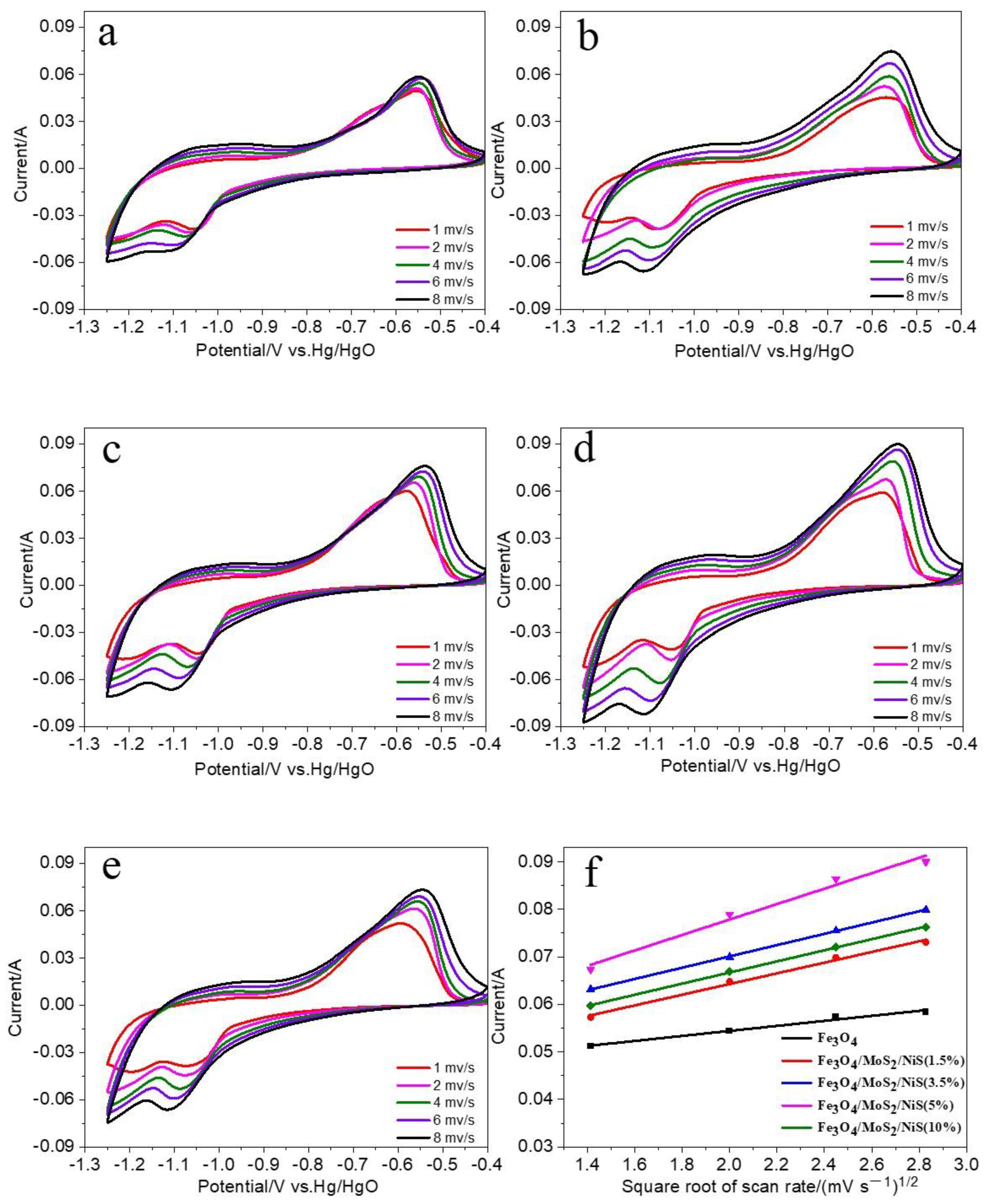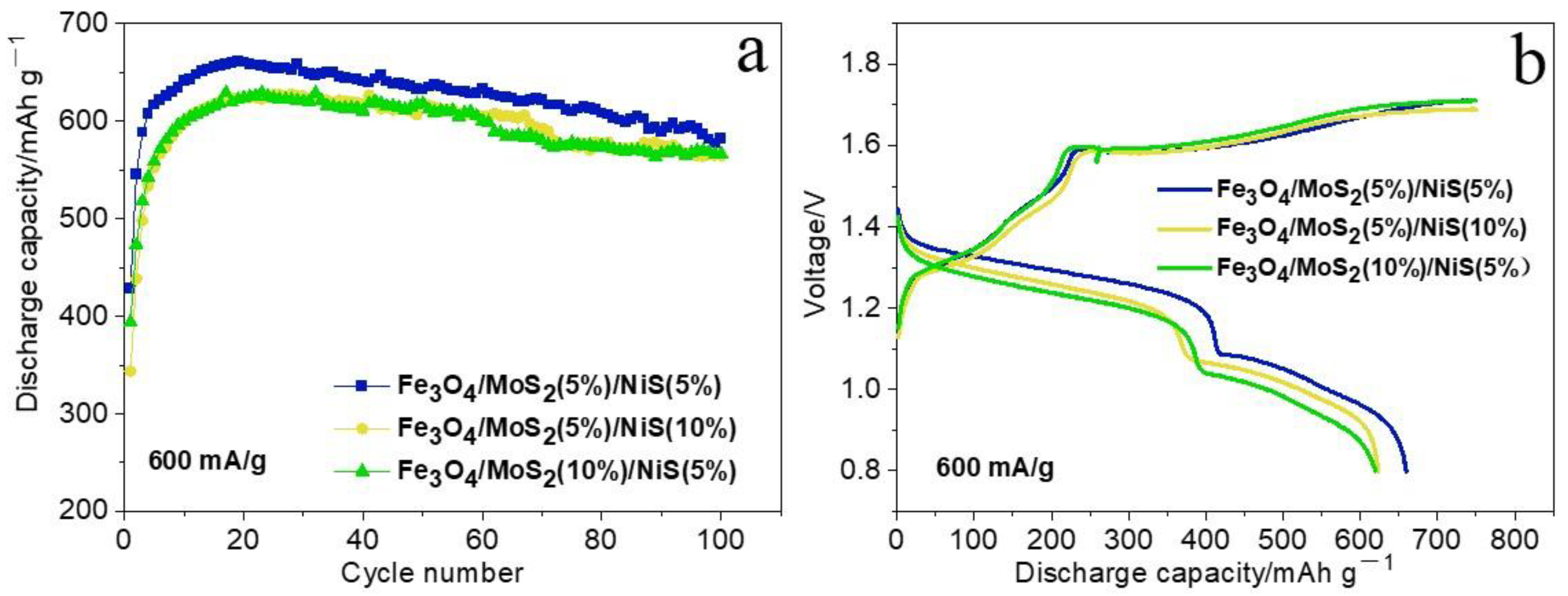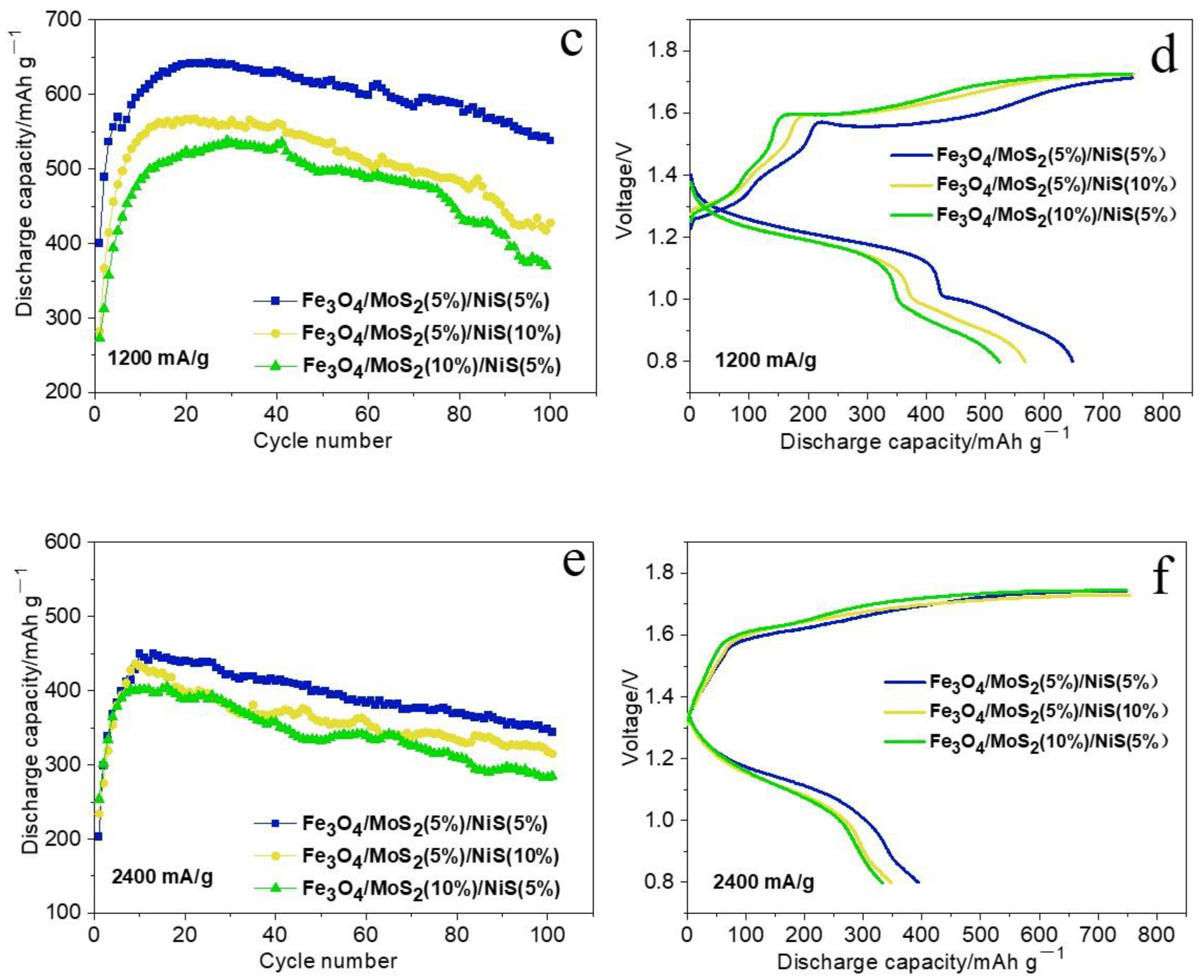3.1. Structural and Morphological Analyses of the Fe3O4, NiS, MoS2 and Fe3O4/MoS2/NiS (5%) Samples
Figure 1 shows the XRD patterns of the Fe
3O
4, NiS, MoS
2, and Fe
3O
4/MoS
2/NiS (5%) samples. As shown in
Figure 1, all the diffraction peaks of Fe
3O
4 are consistent with the standard card PDF#75–0033, and the characteristic diffraction peaks are located at 30.12°, 35.47°, 43.11° and 62.59°, corresponding to the (220), (311), (400) and (440) crystal planes of Fe
3O
4, respectively. All the diffraction peaks of the MoS
2 provided by the Henan Kelong Company (Xinxiang, China) correspond well to the standard card PDF#77–1716, with diffraction peaks at 14.40°, 32.69°, 39.56° and 49.81° corresponding to the (002), (100), (103) and (105) crystal planes of MoS
2. The XRD pattern of the NiS products synthesized at room temperature has no obvious diffraction peaks, except three weak peaks at 2θ values of approximately 30.57°, 34.54° and 54.18°, indicating that amorphous NiS is generated. The XRD pattern of the Fe
3O
4/MoS
2 (5%)/NiS (5%) mixed material clearly shows that the characteristic peaks of each material remain after mixing, indicating that Fe
3O
4 and the MoS
2 and NiS additives are physically mixed, and no chemical reaction occurs between them.
Figure 2 shows field emission scanning electron microscopy images of the MoS
2, NiS, Fe
3O
4 and Fe
3O
4/MoS
2/NiS (5%) samples. The scanning electron microscopy images of MoS
2 at different magnifications in
Figure 2a,b indicate that MoS
2 has a two-dimensional multilayer nanosheet structure.
Figure 2c,d shows SEM images of NiS synthesized at room temperature at different magnifications. NiS has an irregular particle structure formed by the aggregation of many small crystal grains. As shown in
Figure 2e, the Fe
3O
4 material is composed of spherical nanoparticles with a diameter of approximately 200 nm bonded together to form a multivoid particle structure.
Figure 2f is the SEM image of the mixed sample of the three materials. The amorphous NiS particles and the layered MoS
2 nanosheets are fused with the porous Fe
3O
4 through the physical grinding method, ensuring uniform mixing of the electrode materials.
Figure 3a shows the EDX images of Fe
3O
4/MoS
2/NiS (5%) powder. Five elements, Fe, O, S, Ni and Mo, are present and evenly distributed.
Figure 3b shows the EDX images of the Fe
3O
4/MoS
2/NiS (5%) electrode sheet obtained by mixing with the PTFE binder.
Figure 3b also shows the presence and even distribution of Fe, O, S, Ni, and Mo, indicating that all the elements are still evenly distributed during the preparation of the electrode sheet by slurry blending.
As shown in
Figure S1a, the MoS
2 and NiS were successfully added in the Fe
3O
4 anode. The 2p
3/2 peaks of Fe(III) and Fe(II) at 714.08 eV and 712.61 eV, and the corresponding 2p
1/2 peaks at 727.56 eV and 725.72 eV are considered as the specific spectrum of Fe
3O
4 (
Figure S1b) [
37]. The binding energy (BE) values for the most intense Mo 3d (
Figure S1d) and S 2p (
Figure S1e) doublets were found to be 230.80 eV (Mo 3d
5/2) and 162.35 eV (S 2p
3/2) [
38]. These values correspond to MoS
2 peaks reported in previous work. As shown in
Figure S1f, the binding energy at 857.1 and 874.65 eV represent the existence of Ni
2+, which agrees well with the reported literature [
39]. The XPS test results further show that MoS
2 and NiS additives were successfully added to Fe
3O
4 anode.
3.2. Electrochemical Performance Analysis
Figure 4a–d show the charging-discharging curves of the Fe
3O
4, Fe
3O
4/MoS
2, Fe
3O
4/NiS, and Fe
3O
4/MoS
2/NiS electrodes (where MoS
2:NiS = 1:1) with additive contents of 1.5%, 3.5%, 5%, and 10%, respectively, at a current density of 300 mA g
−1.
Figure 4e-h show the relationship between the discharge capacity of the iron electrode and the number of cycles at a current density of 300 mA g
−1.
As shown in
Figure 4a–d, the same trend is observed for each proportion of additives used, and two obvious discharge platforms corresponding to the oxidation process of the iron electrode (the electrode reaction processes of Fe/Fe
2+ and Fe
2+/Fe
3+) appear. The discharge plateau voltage trend is Fe
3O
4 < Fe
3O
4/MoS
2 < Fe
3O
4/NiS < Fe
3O
4/MoS
2/NiS, and the discharge capacity trend is Fe
3O
4 < Fe
3O
4/MoS
2 < Fe
3O
4/NiS < Fe
3O
4/MoS
2/NiS. These results show that compared with the pure Fe
3O
4 electrode, the iron electrodes with MoS
2 and NiS additives have higher discharge capacities, higher discharge plateau voltages and lower charging plateau voltages, which indicates that the internal resistance of the electrode reaction and the electrode polarization degree are reduced, and the reversibility of the electrode reaction is improved. For the Fe
3O
4/MoS
2 electrode, this phenomenon may be related to the two-dimensional layer structure of MoS
2. During the grinding process of the Fe
3O
4 active material and MoS
2 additive, the peeling and lubricity of the MoS
2 sheets enable the Fe
3O
4 particles to easily adhere to the lamella, which helps to increase the contact area with the active substance and is more conducive to charge transfer. Thus, the proton transfer rate and the discharging platform voltage increase, whereas the polarization degree of the electrode and the charging platform voltage decrease. Because NiS itself is an electrode material with good conductivity, adding a certain amount of NiS to the electrode material increases the conductivity of the electrode material, thereby reducing the internal resistance of the reaction and electrode polarization. When MoS
2 and NiS additives are mixed with the active material at the same time, the synergistic promotion of the two additives further increases the conductivity of the electrode, reduces the ohmic polarization, and increases the reversibility of the electrode reaction, which is manifested in the charge and discharge platforms, i.e., the discharge platform is higher, whereas the charging platform is lower. A series of experimental comparisons reveal that when a certain amount of MoS
2 or NiS is added to the electrode material, the discharge capacity and cycling stability of the electrode material are improved, and the electrode polarization is smaller than that of the Fe
3O
4 electrode. However, we find that Fe
3O
4 electrodes with both MoS
2 and NiS as additives exhibit a higher discharge capacity and cycling stability and lower electrode polarization.
Figure 4e–h shows that whether only one additive (Fe
3O
4/MoS
2 electrode or Fe
3O
4/NiS electrode) or two additives (Fe
3O
4/MoS
2/NiS electrode, where MoS
2:NiS = 1:1) are used, the discharge capacity is significantly improved relative to that of the pure Fe
3O
4 reference electrode; this phenomenon is especially obvious when a certain amount of only NiS is used or when two additives are used at the same time (MoS
2:NiS = 1:1). An example is shown in
Figure 4g where the amount of additive is 5%. At a current density of 300 mA g
−1, the specific discharge capacity of the Fe
3O
4 electrode can reach 562.1 mAh g
−1 in the first 40 cycles, and the capacity decreases in the subsequent cycles. After 100 cycles, the capacity retention rate is 75.7%. When the Fe
3O
4/MoS
2 (5%) mixed material is used as the negative material, the specific discharge capacity can reach 609.9 mAh g
−1 in 100 cycles, and the capacity retention rate can reach 88.1% after 100 cycles. The cause for the increased capacity may be related to the two-dimensional layered structure of MoS
2; compared with the morphology of Fe
3O
4, which consists of spherical particles that aggregate to form secondary particles, the morphology of MoS
2 is multilayer lamellar structure with a larger specific surface area, which can provide more chemical reaction sites and ion diffusion channels for the electrochemical reaction process and thus may explain the improvements in the specific discharge capacity and cycling stability. In addition,
Figure 4g shows that the specific discharge capacity of the Fe
3O
4/NiS (5%) electrode can reach 631.4 mAh g
−1 during cycling, and the capacity retention rate is 88.4% after 100 cycles. In this case, the increase in the specific discharge capacity of the iron electrode can be attributed to the combined effect of Ni
2+ and S
2−. In the process of charging and discharging, insoluble Fe(OH)
2 is easily deposited on the surface of the iron electrode, which hinders the further reaction of internal Fe
3O
4 and reduces the utilization rate of the electrode material. However, the presence of S
2− can inhibit the formation of a passivation film on the surface of the iron electrode and the occurrence of the hydrogen precipitation reaction, and thus the utilization rate of the active materials and charging efficiency are improved to a certain extent. During the reaction process, Ni
2+ may form Ni(OH)
2, which has a similar crystal lattice to Fe(OH)
2 and inhibits structural changes to a certain extent. The combined action of the two elements increases the specific discharge capacity and enhances the cycling performance of the electrode. Moreover, we find that when two additives are added at the same time in a ratio of 1:1 instead of alone as a single additive (Fe
3O
4/MoS
2 electrode or Fe
3O
4/NiS electrode), the discharge capacity of the Fe
3O
4/MoS
2/NiS electrode is higher during the charge and discharge process. For example, the discharge capacity of the Fe
3O
4/MoS
2/NiS (5%) electrode can reach 638.7 mAh g
−1, and after 100 cycles, it still retains a capacity of 584 mAh g
−1. The electrode exhibits an excellent discharge capacity and cycling stability, which can be attributed to the synergistic effect of MoS
2 and NiS.
The XRD and XPS results of Fe
3O
4/MoS
2/NiS after cycling are provided in the
Supplementary Materials (Figures S2 and S3). Compared with the primary Fe
3O
4/MoS
2/NiS (5%), the XRD peaks of the electrode after 100 cycles correspond to nickel foam and MoS
2, respectively. No other new peaks are found, indicating that the crystal structure is stable after cycling. The full and high-resolution XPS spectrum also indicate that the composition of Fe
3O
4/MoS
2/NiS (5%) electrode after cycling has not changed obviously. Therefore, both XRD and XPS results of the materials after cycling indicate that the sulfide additives can reduce the electrode polarization and improve the cycling stability. In conclusion, as directly shown in
Figure 4, compared with the pure Fe
3O
4 reference electrode, the Fe
3O
4/MoS
2 (5%), Fe
3O
4/NiS (5%) and Fe
3O
4/MoS
2/NiS (5%) electrodes have significantly improved discharge capacities and cycling performances. Among them, the Fe
3O
4/MoS
2/NiS (5%) electrode exhibits the highest specific discharge capacity and best cycling performance.
To study the effects of MoS
2/NiS addition on the electrical properties of iron electrodes, Fe
3O
4, Fe
3O
4/MoS
2/NiS (1.5%), Fe
3O
4/MoS
2/NiS (3.5%), Fe
3O
4/MoS
2/NiS (5%), and Fe
3O
4/MoS
2(/NiS (10%) electrodes were prepared. Charge and discharge tests were conducted at current densities of 300 mA g
−1, 600 mA g
−1, 1200 mA g
−1, and 2400 mA g
−1. The experimental results are shown in
Figure 5. As shown in
Figure 5a–d, compared with the discharge capacity of the pure Fe
3O
4 electrode, the discharge capacity of the Fe
3O
4/MoS
2/NiS electrode is significantly higher at both small and large current densities, and the discharge capacity gradually increases with increasing additive proportion.
When 5% of both MoS
2 and NiS are added, the specific capacity is the highest; in particular, the discharge capacitance increases more obviously at a high current density. For example, at a current density of 600 mA g
−1, the discharge capacities of the Fe
3O
4, Fe
3O
4/MoS
2/NiS (1.5%), Fe
3O
4/MoS
2/NiS (3.5%), Fe
3O
4/MoS
2/NiS (5%), and Fe
3O
4/MoS
2/NiS (10%) electrodes are 449.6 mAh g
−1, 575.7 mAh g
−1, 648.1 mAh g
−1, 657.9 mAh g
−1, and 621.2 mAh g
−1, respectively. At a current density of 1200 mA g
−1, the discharge capacities of the Fe
3O
4, Fe
3O
4/MoS
2/NiS (1.5%), Fe
3O
4/MoS
2/NiS (3.5%), Fe
3O
4/MoS
2/NiS (5%), and Fe
3O
4/MoS
2/NiS (10%) electrodes is 375.9 mAh g
−1, 496.1 mAh g
−1, 626.5 mAh g
−1, 639.8 mAh g
−1, and 624 mAh g
−1, respectively. At a current density of 2400 mA g
−1, the discharge capacity of the Fe
3O
4, Fe
3O
4/MoS
2/NiS (1.5%), Fe
3O
4/MoS
2/NiS (3.5%), Fe
3O
4/MoS
2/NiS (5%), and Fe
3O
4/MoS
2/NiS (10%) electrodes is 359.1 mAh g
−1, 385.5 mAh g
−1, 432.1 mAh g
−1, 442.1 mAh g
−1, 429.6 mAh g
−1, respectively. Therefore, at different current densities, the trend in the specific discharge capacity of each electrode is Fe
3O
4/MoS
2/NiS (5%) > Fe
3O
4/MoS
2/NiS (3.5%) > Fe
3O
4/MoS
2/NiS (10%) > Fe
3O
4/MoS
2/NiS (1.5%) > Fe
3O
4. The discharge curves in
Figure 5e–h show that the addition of sulfides in different proportions significantly increases the discharge platform voltage, reduces the charging platform voltage and the polarization degree of the electrode, and improves the reversibility of the reaction. In comparison, it is found that regardless of the current density, the Fe
3O
4/MoS
2/NiS (5%) electrode has the highest discharge plateau, revealing excellent electrochemical performance. Therefore, according to the above experimental study, we find that when 5% MoS
2 and NiS are added to the Fe
3O
4 electrode in a 1:1 ratio, the highest specific discharge capacity, smallest electrode polarization, and optimal electrode reaction reversibility are achieved.
To further study the influence of MoS
2 and NiS additives on the electrical properties of iron electrodes, cyclic voltammetry measurements of the pure Fe
3O
4 electrode and Fe
3O
4/MoS
2/NiS electrodes with different additive proportions were performed.
Figure 6a–e show the CV curves of the Fe
3O
4, Fe
3O
4/MoS
2/NiS (1.5%), Fe
3O
4/MoS
2/NiS (3.5%), Fe
3O
4/MoS
2/NiS (5%), and Fe
3O
4/MoS
2/NiS (10%) electrodes at different scanning speeds. In
Figure 6a–e, the CV curves of the five electrodes all show a pair of obvious redox peaks. With increasing scanning speed, the peak potential of the oxidation peak moves in a more positive direction and the peak potential of the reduction peak moves in a more negative direction. The potential difference increases gradually, which indicates that the polarization of each electrode increases with increasing current density. Through observation, we find that, at a given scanning speed, the degrees to which the redox peak current and the corresponding peak area increase are obviously different for the different sample electrodes. In comparison, the addition of two kinds of sulfide significantly affects the redox behavior of Fe
3O
4 electrodes. The peak currents of the Fe
3O
4/MoS
2/NiS electrodes are always higher than that of the pure Fe
3O
4 electrode, indicating that the addition of a sulfide additive helps to reduce the charge and ion transfer resistances and increases the conductivity of the electrode, thereby improving the high-current discharge performance of the electrode.
Figure 6f shows the relationship between the anodic peak current and the square root of the scanning rate. As shown in
Figure 6f, at a given scanning speed, the five sample electrodes have different peak currents. Among them, the Fe
3O
4/MoS
2/NiS (5%) electrode has the largest peak current, indicating that it has a faster electrode reaction rate. According to
Figure 6f, the fitted slopes of the five sample electrodes are 0.00528, 0.01124, 0.01187, 0.01625, and 0.0117. The magnitude of the slope can be used to indicate the magnitude of the diffusion coefficient. Based on the fitted data, the slope of the Fe
3O
4/MoS
2/NiS (5%) electrode is clearly the largest, and the corresponding diffusion coefficient calculated according to the Randles–Sevcik equation is the largest, indicating that the increase in the transfer speed of OH
− helps to increase the reaction speed of the electrode. These results are consistent with the aforementioned charging-discharging trend.
Table 1 lists the cathodic and anodic peak potentials of the five electrodes at a scanning speed of 2 mV/s, where E
O and E
R represent the anode and cathode peak potentials, respectively, and △(E
O-R) represents the difference between the anode and cathode peak potentials, which reflects the reversibility of the reaction. The smaller the value of △(E
O-R) is, the better the reversibility of the reaction is. According to the table, the △(E
O-R) value of the electrode decreases with increasing addition amount of MoS
2 and NiS, and the △(E
O-R) value of the Fe
3O
4/MoS
2/NiS (5%) electrode is the smallest, indicating that the reaction reversibility of the Fe
3O
4/MoS
2/NiS electrode is the best at this ratio. For the electrode with 10% addition, the increase in the △(E
O-R) value may be related to the decrease in the Fe
3O
4 active substance.
Figure 7 shows the EIS profiles of the Fe
3O
4 electrode and Fe
3O
4/MoS
2/NiS electrodes with different proportions of additives at open-circuit voltage. EIS was performed at frequencies between 1 mHz and 10 kHz. Here, Rs represents the total resistance of the electrolyte; Rc1 and Rc2 are the charge transfer resistances of the iron electrode and Ni(OH)
2 counter electrode, respectively; CPE represents the electric double layer capacitance and W represents the Warburg impedance. The charge transfer resistance of the electrode is an important parameter for measuring the speed of the electrode reaction. A large charge transfer resistance indicates that the electrode reaction resistance is large, which is not conducive to the electrode reaction. In contrast, the smaller the charge transfer resistance is, the stronger the depolarization ability of the electrode reaction is. According to the curve fitted by the equivalent circuit, the trend in the charge transfer resistances of the five sample electrodes is: Fe
3O
4 (1.064 Ω cm
2) > Fe
3O
4/MoS
2/NiS (1.5%) (0.5454 Ω cm
2) > Fe
3O
4/MoS
2/NiS (10%) (0.5397 Ω cm
2) > Fe
3O
4/MoS
2/NiS (3.5%) (0.4638 Ω cm
2) > Fe
3O
4/MoS
2/NiS (5%) (0.4328 Ω cm
2). It can be seen that adding a certain amount of MoS
2 and NiS can effectively reduce the charge transfer resistance, which is beneficial to the electrode reaction. The decrease in the charge transfer resistance may be attributed to the fact that S
2− in MoS
2 and NiS can adsorb on the surface of the iron electrode, inhibiting the formation of a passivation film on it. The increase in the contact surface between MoS
2 and Fe
3O
4 is beneficial for decreasing the polarization of the electrode, and NiS with its good conductivity is beneficial for increasing the conductivity of the iron electrode. In addition, the synergistic effect of the two sulfides on the iron electrode results in the best electrochemical performance.
In the above study, the ratio of MoS
2:NiS was fixed at 1:1, and the effects of different addition amounts on the performance of iron electrodes were investigated. To determine the optimal addition ratio of MoS
2 and NiS, we used Fe
3O
4/MoS
2/NiS (5%) as the comparison standard and changed the addition ratio of MoS
2 and NiS to prepare Fe
3O
4/MoS
2 (10%)/NiS (5%) and Fe
3O
4/MoS
2 (5%)/NiS (10%) electrodes.
Figure 8 shows the cycle capacity graphs and charging-discharging curves of the Fe
3O
4/MoS
2/NiS (5%), Fe
3O
4/MoS
2 (10%)/NiS (5%), and Fe
3O
4/MoS
2 (5%)/NiS (10%) electrodes at current densities of 600 mA g
−1, 1200 mA g
−1, and 2400 mA g
−1. As shown in
Figure 8a,c,e, the Fe
3O
4/MoS
2/NiS (5%) electrode has the highest discharge capacity and the best cycling stability at different current densities and exhibits a relatively excellent electrochemical performance at high current densities in particular. Similarly,
Figure 8b,d,f shows that, for the same number of cycles, the Fe
3O
4/MoS
2/NiS (5%) electrode has the largest discharge capacity, a higher discharge voltage plateau and a lower charging platform, that is, it exhibits the smallest electrode polarization, indicating that the reaction has the best reversibility. In summary, after a series of experiments, we conclude that when the additive ratio of MoS
2:NiS is 1:1 and the addition amount is 5%, the discharge capacity of nickel-iron batteries is the highest, the electrode polarization is the smallest, and the battery reaction reversibility is the best.
Under the same conditions, cyclic voltammetry tests were performed for the Fe
3O
4/MoS
2 (5%)/NiS (5%), Fe
3O
4/MoS
2 (10%)/NiS (5%) and Fe
3O
4/MoS
2 (5%)/NiS (10%) electrodes, and the test results are shown in
Supplementary Materials Figure S4a–c. The CV curves of the three electrodes have similar shapes with a pair of obvious redox peaks. With increasing scanning speed, the oxidation peak shifts to the right and the reduction peak shifts to the left.
Table S1 shows the peak potentials and potential differences between the anode and cathode of the three sample electrodes at a scanning speed of 1 mV/s (see
Supplementary Materials). △(E
O-R) represents the difference between the anode peak potential (E
O) and cathode peak potential (E
R). The smaller △(E
O-R) is, the better the reversibility of the electrode reaction is.
Table S1 shows that the reversibility of the electrode reaction is as follows: Fe
3O
4/MoS
2 (5%)/NiS (5%) > Fe
3O
4/MoS
2 (5%)/NiS (10%) > Fe
3O
4/MoS
2 (10%)/NiS (5%), that is, the Fe
3O
4/MoS
2 (5%)/NiS (5%) electrode has the best reversibility in the process of the charging-discharging reaction, which is consistent with the results of the aforementioned charging-discharging curves.
Figure S4d shows the relationship between the anodic peak current and the square root of the scanning rate. As shown in
Figure S4d, at different scanning speeds, each sample electrode has a different peak current, and at a given scanning speed, the Fe
3O
4/MoS
2 (5%)/NiS (5%) electrode has the highest peak current, revealing its better conductivity and faster electrode reaction rate. According to
Figure S4d, the fitted slopes of the three sample electrodes are 0.01784, 0.01755, and 0.01607. It can be inferred from these fitting results that the Fe
3O
4/MoS
2 (5%)/NiS (5%) electrode has the largest diffusion coefficient, which is more conductive to improving the reaction speed.
For the above three sample electrodes, we also conducted AC impedance tests, and the test results are shown
Supplementary Materials in Figure S5. According to the curve fitted by the equivalent circuit, the relationship between the charge transfer resistances of the three electrodes can be clearly observed, i.e., Fe
3O
4/MoS
2 (5%)/NiS (5%) (0.4328 Ω cm
2) < Fe
3O
4/MoS
2 (5%)/NiS (10%) (0.4799 Ω cm
2) < Fe
3O
4/MoS
2 (10%)/NiS (5%) (0.5514 Ω cm
2).
In summary, according to the above electrochemical analysis, it can be seen that the optimal ratio of NiS and MoS2 added to the Fe3O4 electrode is 5% of the mass of the active substance. At this ratio, the electrode has a small electrode transfer charge, better electrode reaction reversibility, and a larger diffusion coefficient, resulting in excellent electrochemical performance.
